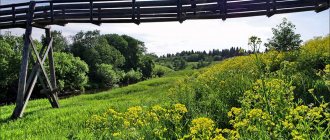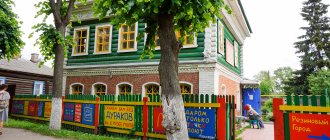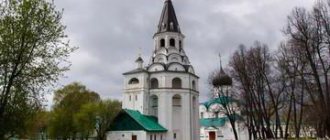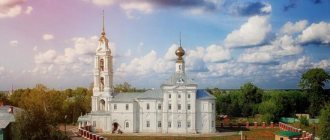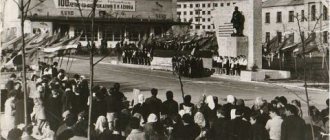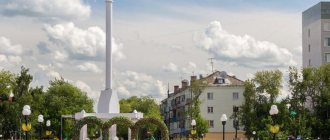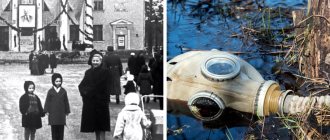Story
Base
The exact time and place of its foundation are unknown; there is evidence that the city existed in the 10th century, but not on the southern, but on the northern shore of Lake Chukhloma (where the Avraamiev Gorodetsky Monastery was later founded). The year of foundation of Chukhloma on the southern coast is considered to be 1381 (the year of the first mention of Chukhloma in literary sources).
Remote from the main transit routes, Chukhloma was not considered a trading town. Its population subsisted on crafts and small trade. A significant part of the residents were engaged in fishing and gardening. The lack of pasture land limited the possibilities for raising livestock and hampered the development of butter and cheese making. The only enterprise that existed in Chukhlom was the brewery of the tax farmer Nelidov, recorded in documents of 1844.
Time of Troubles
Chukhloma suffered greatly during the Time of Troubles.
Chronology
- 10th century - settlement on the northern shore of Lake Chukhloma.
- 11th century - the future Venerable Abraham of Rostov was born in Chukhloma.
- 1381 - mentioned in chronicles as a city within the Principality of Galich
- XVI century - Chukhloma lands formed their own administrative-territorial unit - the Chukhloma siege, in the center of which was the city of Chukhloma
- 1719 - according to the territorial division of Peter I, Chukhloma became the administrative center of the Chukhloma district and became part of the Galician province of the Arkhangelsk province
- 1778 - by decree of Catherine II, Chukhloma became a district town of the Chukhloma district of the Kostroma governorate. Since 1796 - part of the Kostroma province
- 1928 - Zoning is carried out in the Kostroma province. Chukhloma becomes the administrative center of Chukhloma district
- 1929 - Kostroma province was transformed into the Kostroma district of the Ivanovo-Voznesensk (Ivanovo) Industrial Region
- 1936 - Ivanovo Industrial Region is divided into Ivanovo and Yaroslavl regions. Chukhloma and Sudai were assigned to Yaroslavl
- 1944 - the Kostroma region was formed, which included the Chukhloma and Sudai districts
- 1963 - Sudai district was abolished and became part of Chukhloma rural district
- 1965 - Chukhloma rural district was transformed into a district with the same status
- 2004 - In accordance with the administrative reform, the Chukhloma urban settlement and the Chukhloma municipal district were formed
selo3.jpg
Rural church in Bovykino.
1796 Photo from the personal archive of the participants As one of the expedition participants said, the floors are separated by a double floor; if you climb the remains of a wooden staircase, you can see holes in the floor. Frescoes and elements of oil painting are partially preserved on both floors. The size and high-class skill of the masters of the past to build temples for centuries are amazing.
Attractions
The Assumption Church (1730, active) with a hipped bell tower has been preserved; Transfiguration Cathedral (1746, converted into a fire station). Also in the center of Chukhloma are the remains of the earthen ramparts of an ancient fortress of the 15th century. A number of blocks in the city center are built with stone houses from the 19th century; Most of the buildings in Chukhloma are wooden, many are decorated with carvings.
There is a local history museum (since 1919).
11 km north of Chukhloma is the Avraamiyevo-Gorodetsky Monastery (XVII-XIX centuries). Also in the vicinity of the city is the Lermontov family estate.
Streets
Kalinina Street - former Obvalnaya Street. The most important element of the urban layout is the arc street, which connected the rays of the fan-shaped street system and served as the border of the regular city. When the city was built according to the new plan of 1780, Chukhloma was dug in with a small ditch, the earth of which formed a rampart. As a result, the street received the name Obvalnaya, and in 1843 - Ovalnaya. At the entrance to the city from Galich and Kologriv there were outposts, behind which there were forges. The street received its current name after 1917.
Square
Former Trade Square. In 1917 it was renamed Revolution Square. The square got its name from the fact that up to five buildings with shops were built here. Here on the square on market days peasants sold their products. From November 24 to December 1, the Catherine Fair was held on the square. The city's social life was concentrated here. In 1932, the bazaar was moved from this square to Cemetery Street, and was named the Kolkhoz Market.
Trade fairs
Fairs became one of the brightest pages in the history of provincial Chukhloma in the 19th and early 20th centuries, remote from busy communications routes and large shopping centers. In 1839, by order of the Kostroma gubernatorial board, an annual fair was allowed in Chukhloma from December 7 to 14, which was awarded the title “Catherine’s”. December 7 is the day of St. Catherine the Great Martyr. It was the most significant of all the county fairs, the arrival of which was expected a month or more in advance. A week before the opening of the fair, trade booths were built on the square for visiting merchants.
Chukhloma fortress
The time of construction of the Chukhloma fortress is unknown. Approximately this is the end of the 15th and beginning of the 16th centuries. The fortress was located on a high hill at the confluence of the Sandeba River into the lake. On the southern side, the fortress was protected by a cliff of the river bank, on the west by steep hill slopes to the lake, and on the north and east by embankments and ditches, the line of which included two ponds. The height of the ramparts on the floor sides reached 4 meters, and on the other sides no more than 1.5 m. The fortress had the shape of an irregular quadrangle. Wooden walls with quadrangular towers were placed on the ramparts, four of which secured the corners, and two, on the northern and eastern sides, were passageways. The defense system was complemented by three more towers located inside the walls: a high pyramidal lookout with several tiers of bypass galleries and balconies and two lower ones, with one tier of bypasses. The powerful fortifications of the fortress made it possible to hold it during the siege by the Poles in 1609.
On the territory of the fortress there was a cathedral complex. Next to the temples stood the voivode's courtyard, the official hut, the courtyard of the Avraamiev Monastery, the siege houses of the boyars B. I. Morozov, G. I. Maykov, G. I. Gorikhvostov, I. Ya. Koltovsky.
The Chukhloma fortress existed until 1727, when the “great fire” in its furious rampage destroyed all the buildings. The battle towers and walls of the city of Chukhloma perished in the all-consuming flame, and government and private houses disappeared in the fiery fireworks. Only ashes and smoldering firebrands remained from the city Kremlin. On the territory of the ancient fortress there is now a city park.
Transfiguration Cathedral
The Transfiguration Cathedral was built in 1747 at the expense of P. M. Nelyubov and parishioners, replacing the wooden St. Nicholas Church on this site. Later, already in the second half of the 17th century, a bell tower was erected a few meters to the west. Following this, a two-limit refectory was built between the temple and the bell tower. In the 1870s, two symmetrical tents were erected on the sides of the bell tower for the sacristy and gatehouse. Despite its poor preservation, the Transfiguration Cathedral is one of the most striking monuments of its time in the Kostroma region.
The cathedral is located in the central part of the city, southwest of the ancient ramparts. In 1723, during the reign of Peter I, priest Luka Vasiliev and church warden Grigory Dmitriev wrote a petition to the synodal order that “the church has been very dilapidated since ancient times and it is impossible to conduct God’s services in it.” Construction of a new stone church began. Seven years later, in July 1730, the side chapels of the stone church were built and ready for consecration, but the church itself was not yet completed. The consecration took place on July 31. It is this date that is considered to be the beginning of the history of the only surviving church in the city of Chukhloma.
Alexandrovskaya almshouse
The Alexandrovskaya almshouse for the elderly was opened on August 30, 1889. The district zemstvo, wanting to perpetuate the memory of Alexander II, decided to give the city a two-story half-stone house built in the last quarter of the 19th century. The building, which became the main building of the almshouse, was refurbished and 5 thousand rubles were allocated for the maintenance of those in need. I. I. Iyudin was appointed trustee. In 1892, with funds from St. Petersburg merchants D. L. Parfenov and I. N. Boev, a house church was built on the second floor of the almshouse. A two-tier wooden belfry was placed to the left of the house along the red line of the street. During the First World War, an infirmary was built in the almshouse, and after the October Revolution it was transferred to a school.
Children's shelter
The orphanage is an example of a large charitable complex characteristic of its time, playing a significant role in the formation of the historical urban environment of Chukhloma. Built at the expense of natives of the village of M. Svetitsa, merchants and Parfenov brothers. First, in 1903-1905, the main building was built, followed by the southern building and two buildings intended to accommodate personnel. At the beginning of the 20th century, the territory of the complex was landscaped with regular linden plantings. In the first years of the formation of Soviet power, the city hospital was located in the shelter buildings.
The regional center of the Kostroma region, Chukhloma, is located on the eastern shore of Lake Chukhloma, 50 kilometers from Galich and 170 kilometers from Kostroma. The population of Chukhloma is 5.5 thousand people, the territory is 7 square kilometers.
In ancient times, Finno-Ugric tribes - Chud and Merya - lived in these places, as in many northern and eastern regions. The name of the city was inherited from them. Chukhlomskoye Lake in ancient times was called Chudskoye, but later the name Chudskoye was firmly assigned to the lake near the city of Pskov, and Chukhlomskoye became its modern name. In the chronicle, Chukhloma was first mentioned in 1381 as a city included in the Principality of Galicia. But it arose earlier, probably already in the 10th century. Along the Chukhloma road there are untouched forests, swamps, rivers - Lamza, Kast, Viga, Shacha, Nozhiga. There are villages with Finnish names - Edomsha, Vozega, Morega, Chuvatovo, Neronovo, Samylovo, Kokonygino, reminiscent of distant times when the pagan Finno-Ugric peoples Merya and Chud lived here.
During Tatar raids, feudal wars and strife, Chukhloma had an important defensive significance. On the high shore of the lake, ramparts were poured and a wooden fortress was built, which existed until 1727, when it was destroyed by fire. The ramparts have partially survived to this day.
Resident of Chukhloma. First half of the 20th century.
In the 16th century, the Principality of Galich, and with it Chukhloma, became part of the Moscow state, the internecine wars ended, but the long-awaited peace did not come. More than ten times over the course of a century, the Tatars swept through like a hurricane. Lithuanian troops also invaded Chukhloma lands. As a result of another attack on Chukhloma in 1609, the fortress survived, but all the surrounding villages were burned, many people left their native lands, and the Chukhloma region became impoverished. As a result of this, Chukhloma almost turned into a village; according to the patrol book of 1615, there were thirty households with thirty male souls.
By the middle of the 17th century, the number of households reached seventy, trade picked up, and many fishermen appeared on the lake. Boyar mansions were built both on the territory of the fortress and outside its walls. In 1708, Chukhloma, under the administrative reform of Peter, was assigned to the Arkhangelsk province. Later - into the Chukhloma district, formed as part of the Kostroma province of the Kostroma governorship on September 5, 1778. Since 1796, the district became part of the Kostroma province. In 1780, a rectangular new regular city plan was established, on which the city's layout is based to this day. On October 8, 1928, the All-Russian Central Executive Committee adopted a resolution “On the zoning of the Kostroma province”, and the Chukhloma district was formed. In 1929, the Chukhloma district became part of the Kostroma district of the Ivanovo industrial region. In 1936, the Chukhloma region became part of the Yaroslavl region, and in 1944 - into the Kostroma region.
All the ancient wooden buildings: the Kremlin, the boyars' and merchants' chambers, the houses of the townspeople, were destroyed in a fire in 1727. Among the architectural monuments in Chukhloma, the Assumption Church (1730-40), the Transfiguration Cathedral (1746; heavily rebuilt), the former government building (1837) and residential buildings (second half of the 19th century) have been preserved. The territory of the burnt Kremlin was empty for a long time, and in 1837 the city government began renting it out to citizens for vegetable gardens, and this continued for over half a century. In 1890, ditches began to be filled in, and a city garden was laid out on the territory of the former Kremlin. The city garden with its centuries-old trees still exists today. At the end of the rampart, above the lake, there is a gazebo, from which wonderful views of the lake and the city open.
11 kilometers from Chukhloma, on the northern shore of the lake, near the village of Nozhkino, the Avraamiev Gorodetsky Monastery is located. It was founded at the end of the 14th century by Abraham of Galich, but nothing has survived from those times. The oldest building of the monastery is the five-domed Church of the Intercession (1608-1632). The ruins of the gateway St. Nicholas Church also remain from the 17th century. The remaining buildings of the monastery - the Church of the Tenderness of Our Lady (1857), the bell tower and the fraternal building - were built in the 19th century.
Nowadays, the basis of Chukhloma’s economy is the forestry and woodworking industries. Chukhloma carpenters have long been famous for their skill, and this glory has not faded even today. Chukhloma Timber Industry Enterprise OJSC operates in Chukhloma (industrial timber, lumber), butter cheese (production of lumber, garden houses, window and door blocks).
Modern Chukhloma is not very different from Chukhloma of the 19th-20th centuries. The same two-story houses, mostly wooden, the same leisurely pace of life. If there is no car in sight (and this is not uncommon in Chukhloma), it is easy to imagine the district leader of the nobility, a constable or a zemstvo doctor riding out on a carriage.
Almost all the ancient cities of the future Muscovy - Pereslavl, Rostov, Novgorod, Galich, Beloozero, Izborsk - were founded on the shores of lakes. The city of Chukhloma is no exception here. The city itself lies on the hills on the southeastern shore of the lake, and opposite Chukhloma, on the northern shore, also on a hill, there is a monastery. In a straight line it is about 10 kilometers, but the huge temple and bell tower are visible from the city in any weather. This is probably what was once planned by the monk Abraham, a disciple of Sergius of Radonezh, who first came to Lake Chukhloma, on the shores of which the pagan peoples Merya and Chud lived. Abraham chose the most prominent place for the monastery, so that through beauty people would become familiar with the Christian faith.
Just as a few years ago, so now, I walked from the monastery to the city. Walking time is about 2.5 hours. Despite the late evening, trucks carrying timber passed along the highway every now and then towards Kostroma. I have already been told that the local population lives by selling timber, and its logging is usually illegal and the business here is connected with crime. But what should people do if all agriculture in the northern infertile lands is now in decline? What else can they feed on? Halfway along the road, near the village of Pochinok, I saw something completely unimaginable: at a wide table, right by the side of the road,... Caucasians were noisily feasting! Like in Pirosmanishvili’s painting, there are about forty people... Here, you have the “Russian North”!... In addition to the forest, the men in Chukhloma are engaged in the most common “latrine” trade in Russia, which for some reason is usually called here “the construction of bathhouses for Muscovites.” Muscovites call them “guest workers.” It doesn’t matter what the Chukhlomichi people are building in the Mother See and other big cities - bathhouses, dachas, skyscrapers or palaces, but those men who regularly leave for a long time for “fishing” usually return, although not rich, but with quite decent money. That is why in Chukhloma it is difficult to meet beggars or simply “scourges”: everything seems to be in business. In Chukhlomych men one senses some kind of stature, inner self-confidence; you look at such a father of a family, proudly leading his beautiful wife under one arm, and with the other carrying an expensive stroller with a plump child, and you yourself somehow decrease in stature, or something. Now, it’s just not clear: what will happen when all the baths and palaces are built and the entire forest is cut down? After all, not a single production has been established in Chukhloma...
A resident of Chukhloma at the beginning of the 20th century.
Small, with a population of 4 thousand, Chukhloma has always managed to live better than other cities. It’s just that there was such a tradition: to work and not ask “damned” questions about how your work can enrich some “uncle” (damn, there is such a “pimple” in the Russian worldview). Take, for example, the history of the Chukhloma family of the Judins, which dates back to the 16th century. They started with simple things - catching the famous Chukhloma crucian carp and catching the beast - but soon the family rose to the point that one of the Judins, Fyodor Ivanovich, was included in the book of the most noble merchants of the Russian Empire. He enriched himself through international trade, in which a good income was brought in not by raw materials (the sale of which, by the way, Moscow now survives), but by a finished, high-quality product. Iuda convoys with hemp, flaxseed and furs were loaded onto ships and floated down the Sukhona and Dvina to Arkhangelsk, where Fyodor Ivanovich had his own factories. Further, to England and Holland, ropes, leather and superbly crafted furs were sent. The rise of Judin was interrupted by an emergency: in 1809, a caravan with its ships was captured by the Turks. And, although a few years later Iudin was able to return his money as an indemnity, by that time his name had been crossed out from the list of noble merchants and he was declared bankrupt. Fyodor Ivanovich no longer decided to engage in commerce “on a large scale”, he moved to Odessa, and his descendants subsequently dispersed throughout Russia.
Resident of Chukhloma at the beginning of the 20th century.
One of the Yudins, Gennady Vasilyevich, settled in Krasnoyarsk. He became famous not because he also belonged to the merchant class, but for his unique library, which consisted of 80 thousand books and 100 thousand manuscripts. Gennady Vasilyevich, moreover, published a two-volume work “Materials of the city of Chukhloma and the Kostroma family of the Yudins.” At the end of his life, left alone, he offered his library to the tsarist government, but officials were busy solving other problems and rejected the offer. It ended up that in 1907 the collection migrated to America and now it is part of the collection of the US Library of Congress.
Lake Chukhloma gradually lost the meaning it had before: the meaning of a breadwinner. The fact that the coat of arms of Chukhloma features two twisted tin spears on a blue background, designed to remind of the prevalence of fishing here, now, unfortunately, has only historical significance. The main “attraction” of the lake is the famous Chukhloma crucian carp, which were once served at the highest tables, but are now a rarity. In our era, a tragedy occurred, perhaps on a local scale, but comparable to the disappearance of mammoths in ancient times: the crucian carp died. Many people still argue about why this happened. They agreed on only one thing: something had been disrupted in the fragile balance, in the unspoken agreement between nature and man.
A resident of Chukhloma at the beginning of the 20th century.
The author of these lines, photographer and traveler Gennady Mikheev managed to talk about the ecology of the lake and you won’t believe it with whom. With Judas! No, not with Fyodor Ivanovich and not with Gennady Vasilyevich: with Lev Anatolyevich Iyudin, a worthy successor to the traditions of a glorious family. Lev Anatolyevich worked for 46 years as director of the Chukhloma veterinary laboratory, and therefore knows a lot about the biology and problems of the lake. Even Iyudin’s address is “sign”: Ozernaya Street, building 1. He is now retired, but, nevertheless, the pain from what is happening in Iyudin does not subside.
And here’s why: ...Actually, all Chukhlomych residents seem to have a love for our “sea” in their souls. There are no people who are indifferent. My father was a commercial hunter, and my grandfather was also involved in this business. And in general, all of our relatives were connected to the lake to one degree or another. I don’t remember having any problems with the lake before. There were fishermen who carried out industrial fishing, but in those days they treated the lake not as consumers, but with frugality. What has happened in recent years, namely, the “freezes,” is something that could not have been imagined then. - What kind of “freezes” are these? - Just imagine: you go ashore in the morning and look - and the water right up to the horizon is completely dotted with fish that have floated up “belly up.” Well, this happened once with our crucian carp. And after him the ruff died. - Why? - There are many opinions here. In my opinion, the main reason is that hydrogen sulfide accumulated in the bottom part, which was due to the fact that that year there was little wind and no rain, but crucian carp is a bottom-dwelling fish. The lake absorbs many rivers, but only one flows out of it: Vexa. Previously, the Grigorievskaya mill stood on Vex and it was of great importance: its dam maintained the level of the lake. The “sea” itself is not deep, about one and a half meters, and only in the “depths”, which we call Elochnaya, Yuzhnaya and Ozerko, the depth is up to six meters. Well, back then the fish had nowhere to go... - Were there really no dry years in the old days? The fish didn’t die... - Yes, the main thing, of course, is the unsanitary conditions of the lake. All the dirt from the city, organic matter from farms, chemicals from the fields (though now there is no more chemicals because the collective farms have become impoverished) - everything went into the lake. And one more thing: the motorboats were all started, and people developed a habit: they sailed, rinsed out the gasoline tank, and into the lake...
And yet, the lake with an area of 5.5 thousand hectares is still capable of self-cleaning. For example, there are no fertilizers in the fields - all the offspring are fish. They tried to artificially breed the carp, but it took root. True, some experts hinted that the crucian carp was attacked by some unknown disease, but the version of the shallows was unproven. There are still a few crucian carp left. And here’s what Lev Anatolyevich (he himself is an avid fisherman) noticed: crucian carp found a kind of “way out” of the situation: it was able to somehow crossbreed with carp and as a result, strange fish that are very similar to a hybrid often began to be caught in fishing nets crucian carp. The lake is also inhabited by tench, perch, roach (called roach here), and pike. But there can be no talk of industrial-scale fishing.
In the early 90s, fishing artels were dissolved, and soon the Lenin's Path collective farm, which also specialized in fish, was liquidated. After that, complete chaos ensued on the lake. Local fishermen do not favor fishing rods: they fish with nets. And it’s not just fish that get caught in the net. It is also a treacherous trap for game. Nets are officially permitted, and even at a time when ducks are just starting to hatch broods. You get yourself a license and set up a network even a kilometer long. And the fact that both ducks and ducklings can get entangled in it is even considered as luck. In one day, in such an “inhuman” way, you can catch 30 or 50 ducks... Lev Anatolyevich often argues with the fish inspector about these same nets, to which he retorts: “People need to fish in order to live...” Although, some fish breeds are prohibited When fishing, fishermen, as a rule, do not understand what is caught in their net. “Sweep” everything. Our fish inspector is a young, diligent guy,” reflects Iyudin, “but he is the only one for the whole lake and cannot fully control it. Is he able to see that both crucian carp and tench are secretly caught? He would like at least one assistant...
...The next evening there was a celebration on the shore of the lake. Something like “Play-harmony”. Chukhlomichi people love to have fun as much as they love to work. But here’s what I noticed: although the stage was built right at the edge of the “Chukhloma Sea,” almost no one, except perhaps children, paid attention to the surface of the lake, to the bloody sun setting exactly behind such a distant and beautiful monastery. And it seemed to me that some mysterious connection between people and the lake was indeed broken. Maybe it just seemed like it.
I was told this legend. Every year the Chukhloma Sea must “take” at least one human victim. As a reward for this, the lake bestows all its benefits on people. A kind of “agreement”. No one has drowned in the lake for several years. I wanted to ask Lev Anatolyevich about whether this is good or bad (and in general: is the legend true - or so, a fairy tale...). But he did not come to the holiday.
Gennady Mikheev. Kostroma region
selo2.jpg
Nest on the bell tower. Photos from the personal archive of the participants
Fetkulin Andrey: “Complete Chukhloma” is not only a serious expedition, but also a community of like-minded people passionate about a common idea. “Full Chukhloma” happens day and night, dirty cars constantly drive up to the camp from the routes, dirty and tired expedition members go to the field tent for hot tea with sweets and a good mood. Someone is looking for CV joints and bearings, someone is repairing generators with a calibrated blow of an ax. Someone shares their vivid impressions of the expedition day and the routes completed. Someone talks about the signs installed. There is a cinema and a children's tent, fun starts, a bonfire... An atmosphere of friendship reigns in the camp, the joy of achieving goals and understanding the benefits of a common cause.
sorevnovaniya.jpg
Let's relax!
Photo from the personal archive of the participants. Four days of the expedition flew by very quickly and the project organizers are beginning to plan “Full Chukhloma 2022.”
The expedition's long-term research and educational activities have already contributed to the formation of a positive image of the Kostroma region and led to a steady increase in interest and an increase in the number of independent trips of tourists. “Full Chukhloma” is already an integral and recognizable brand of the Kostroma region. That is why all expedition projects are always supported by both the Russian Geographical Society and regional authorities.
See you in a year!
selo5.jpg
Ancient temple frescoes.
Photo from the personal archive of the participants. The temple operated until 1929, then it was closed and the bell was dropped. In the village in the 60s of the 20th century there was a creamery that produced delicious cheese and butter. In 1977, the plant closed, and a few years later both the village itself and the roads leading to it ceased to exist.
During a flyby with a quadcopter, two large nests were discovered on the bell tower. If you look closely, you can see one of them.

